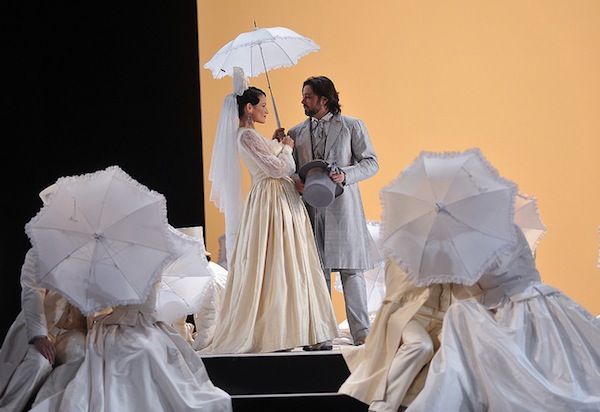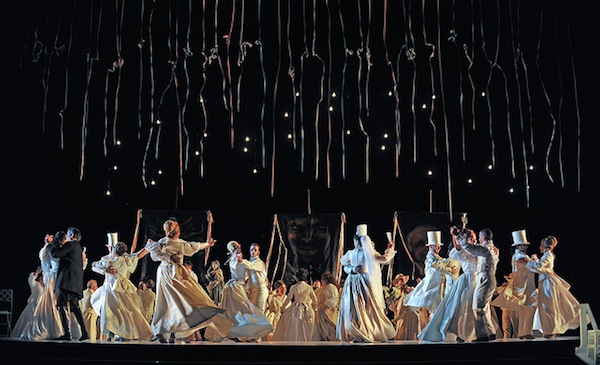
Luisa Fernanda brings lovely zarzuela times to Florida Grand Opera
By Sebastián Spreng, Visual Artist and Classical Music Writer
The start of the 2011-12 Miami classical music season is showing a landing of relevant Spaniards artists (Jordi Savall, Javier Perianes, Ramón Tebar, Pablo Heras Casado to name a few), although the most conspicuous presence is the ensemble bringing a zarzuela to the opening of the Florida Grand Opera’s 71st season. Packed with infectious, catchy tunes, Luisa Fernanda makes a convincing case for the Spanish light opera known as “zarzuela,” a popular genre that flourished during the first decades of the 20th century.
A perennial favorite in Spanish countries, the piece by Federico Moreno Torroba is the first zarzuela chosen in the history of the company and undoubtedly the best choice in difficult times when the unpredictable favor of the audiences does not encourage risks. This title and production by Emilio Sagi opened the doors of zarzuela to the big opera houses and was presented at Milan’s La Scala, Madrid’s Teatro Real, Washington’s National Opera and Los Angeles’s LA Opera. It is now making its last stop at the Florida Grand Opera, co-produced by the Fundación SaludArte.
Accented with creamy curtains, the Spanish director created a minimalist white and black arena. Intense political and amorous passions are performed by singers and actors while interspersed spoken dialogue is kept to a minimum in this version. This spare, ultra-refined frame – that disoriented more than one veteran zarzuela buff – reinforces Luisa Fernanda’s charming sentimentality and lovely lyricism and at the same time promotes international appreciation of the so-called “small genre.”
The Madrid model displayed on the right corner of the stage was the sole geographical indication (and perhaps the only detail that now seems outdated in Sagi’s production) while all the Spanish themes were strictly kept for singers, chorus and the orchestra, where young conductor Pablo Mielgo stamped a persuasive lesson in style.

The impressive Catalonian baritone Angel Odena invested Vidal, a wealthy middle-age landowner turned revolutionary for the love of Luisa, with a magnetic stage presence and big vocal resources. A definitive star in the making, Odena was a real winner with the audience. An experienced Luisa Fernanda, soprano Amparo Navarro was at her best in the soliloquy “Cállate corazón” showing beautiful belcanto line and a polished dark tone. She was confident in the ambivalence of the role and also the ideal antagonist to the splendid Duchess Carolina of Davinia Rodriguez, a Canarian soprano that gave luster and intention to the manipulative monarchic lady. To complete the vocal quartet, Antonio Gandía proved the adequate lyric tenor for the romantic unofficial hymn of Madrid (“De este apacible rincón de Madrid”), his ardent Javier strengthen as the evening progressed and had his best moment in the final duet with Luisa “Subir subir y luego caer”.
The rest of the cast was equally competent, from Raquel Pierotti’s Mariana and Rebekah Diaz’s Rosita to the brief appearances of young artists Marian Lobaina, Daniel Shirley y Martin Nusspaumer. Special mention goes to the FGO chorus under the direction of John Keene showing exemplary Spanish diction.
Curiously for such a light piece, there is no predictable happy ending, rather an open one with the nostalgic and always memorable “Ay mi morena” pervading a whole evening of gallant melodies. With Luisa Fernanda, Florida Grand Opera scored a first milestone that could open new horizons. It could also mark another step towards a better integration of Spanish-speaking audience. Do not miss the chance to see this first-class zarzuela production.
Luisa Fernanda by the Florida Grand Opera: November 22, 23 and 26 (Miami) and December 1 and 3 (Fort Lauderdale); www.fgo.org or 305-854-164 or 1-800-741-1010
Recent Content
-
Artsarticle ·
-
Artsarticle ·
-
Artsarticle ·

